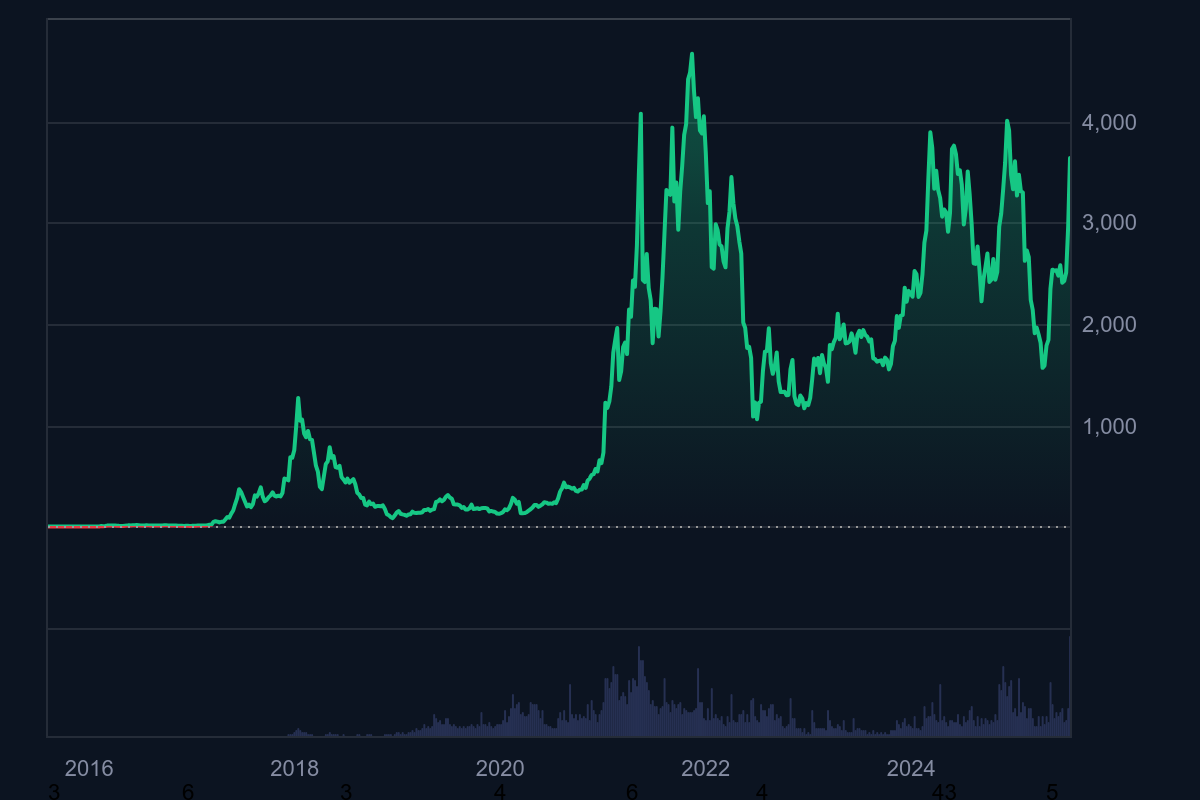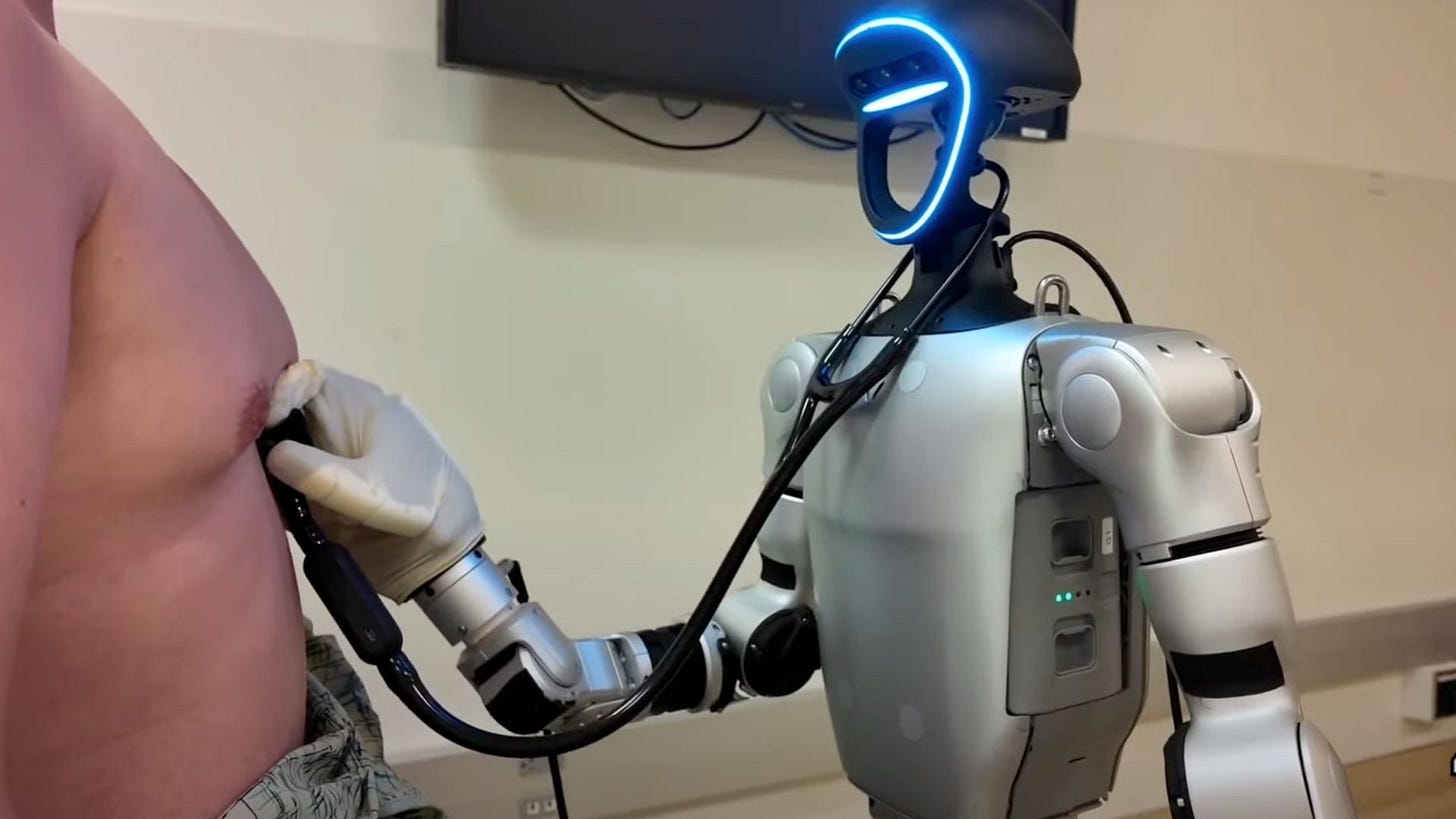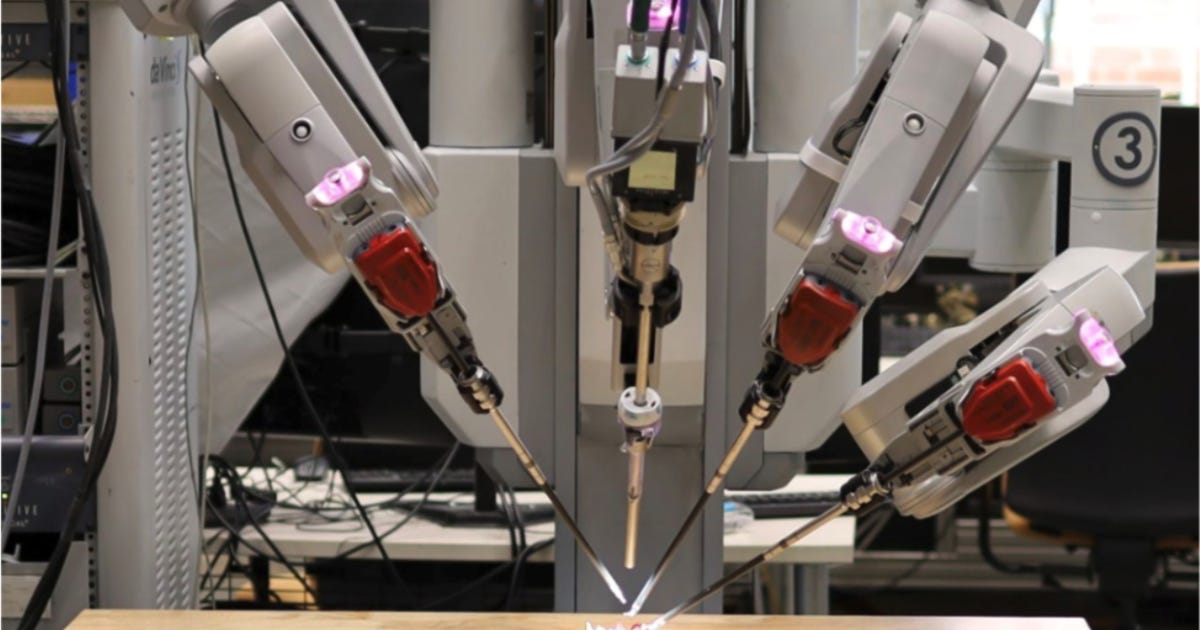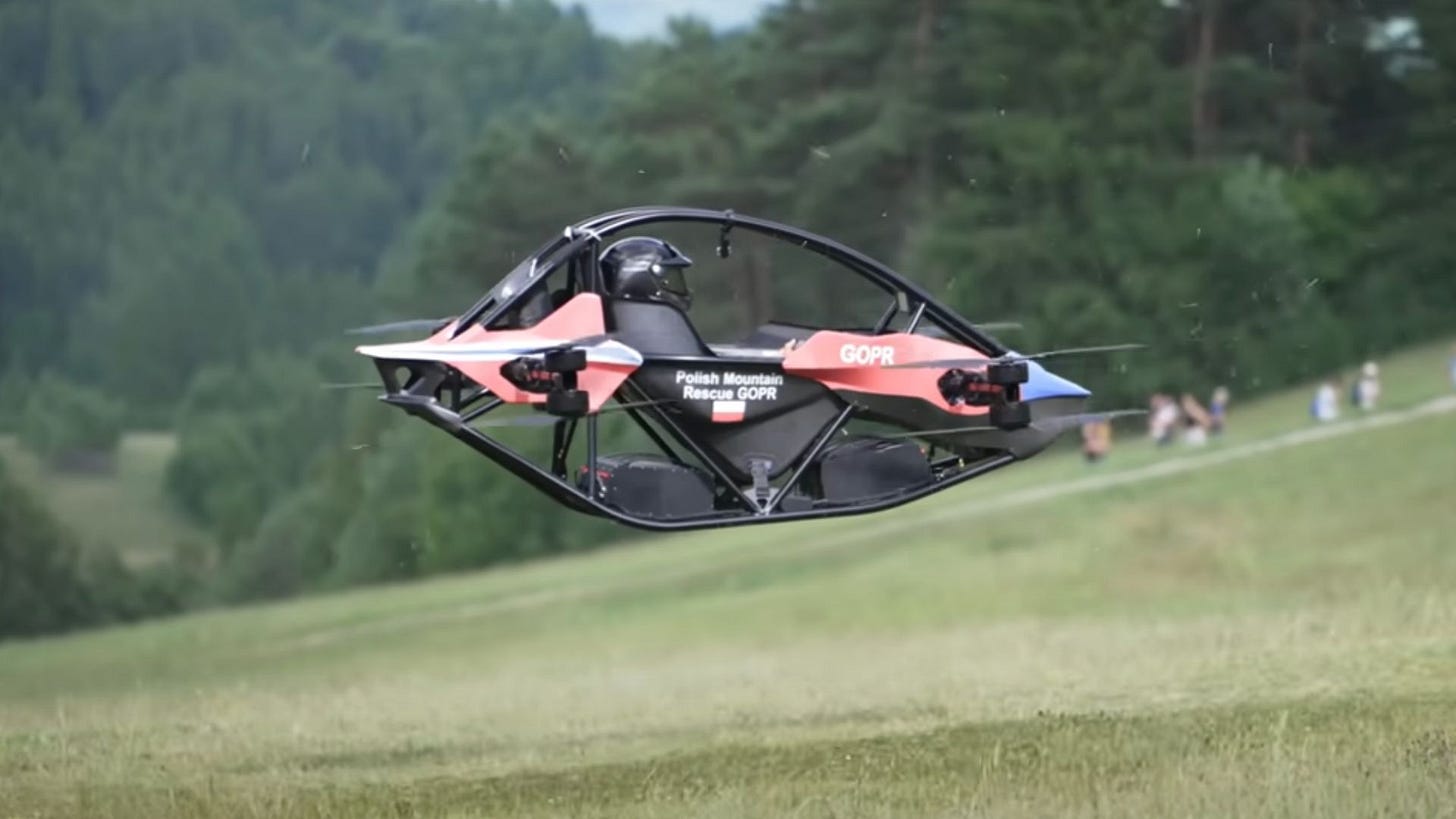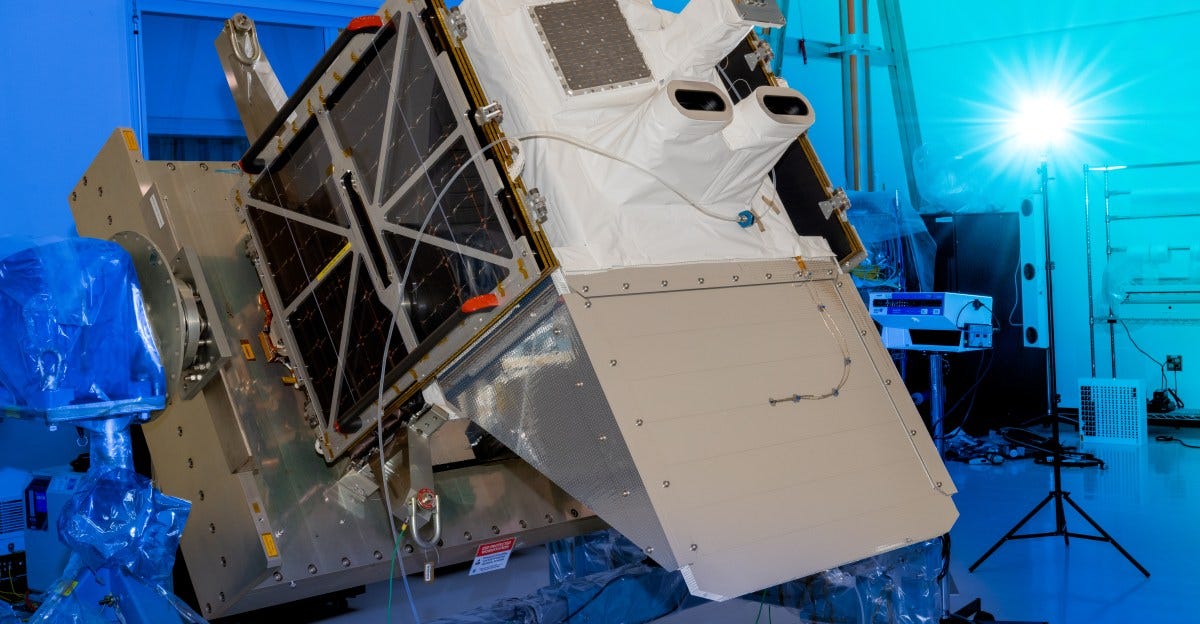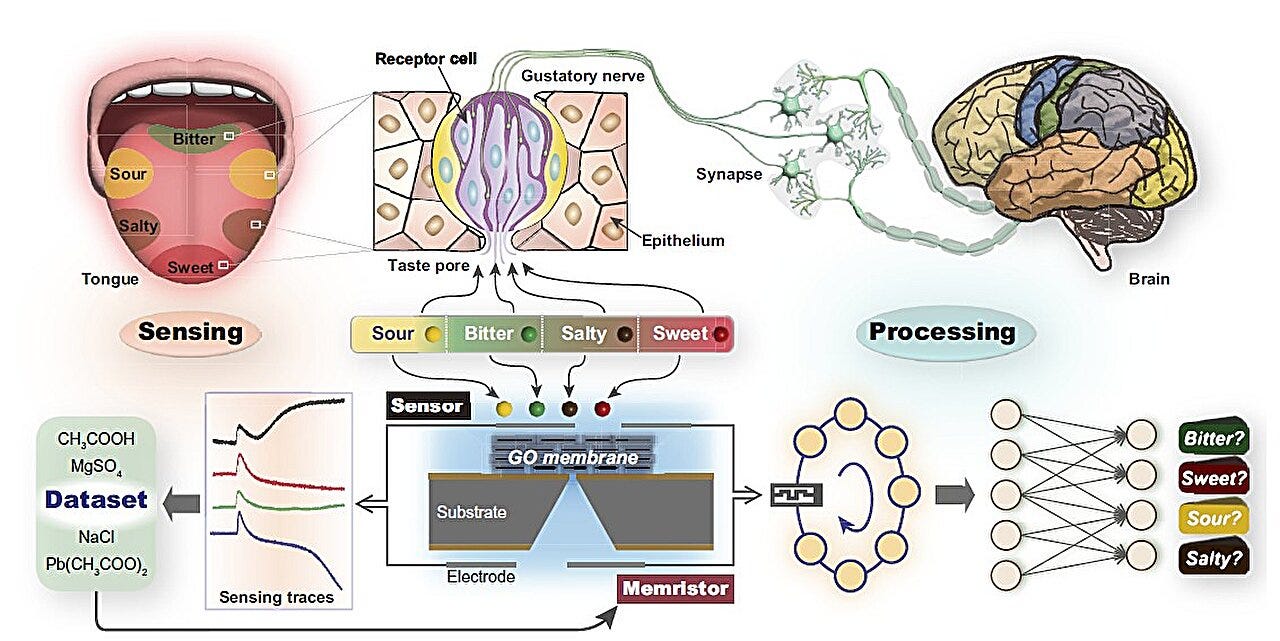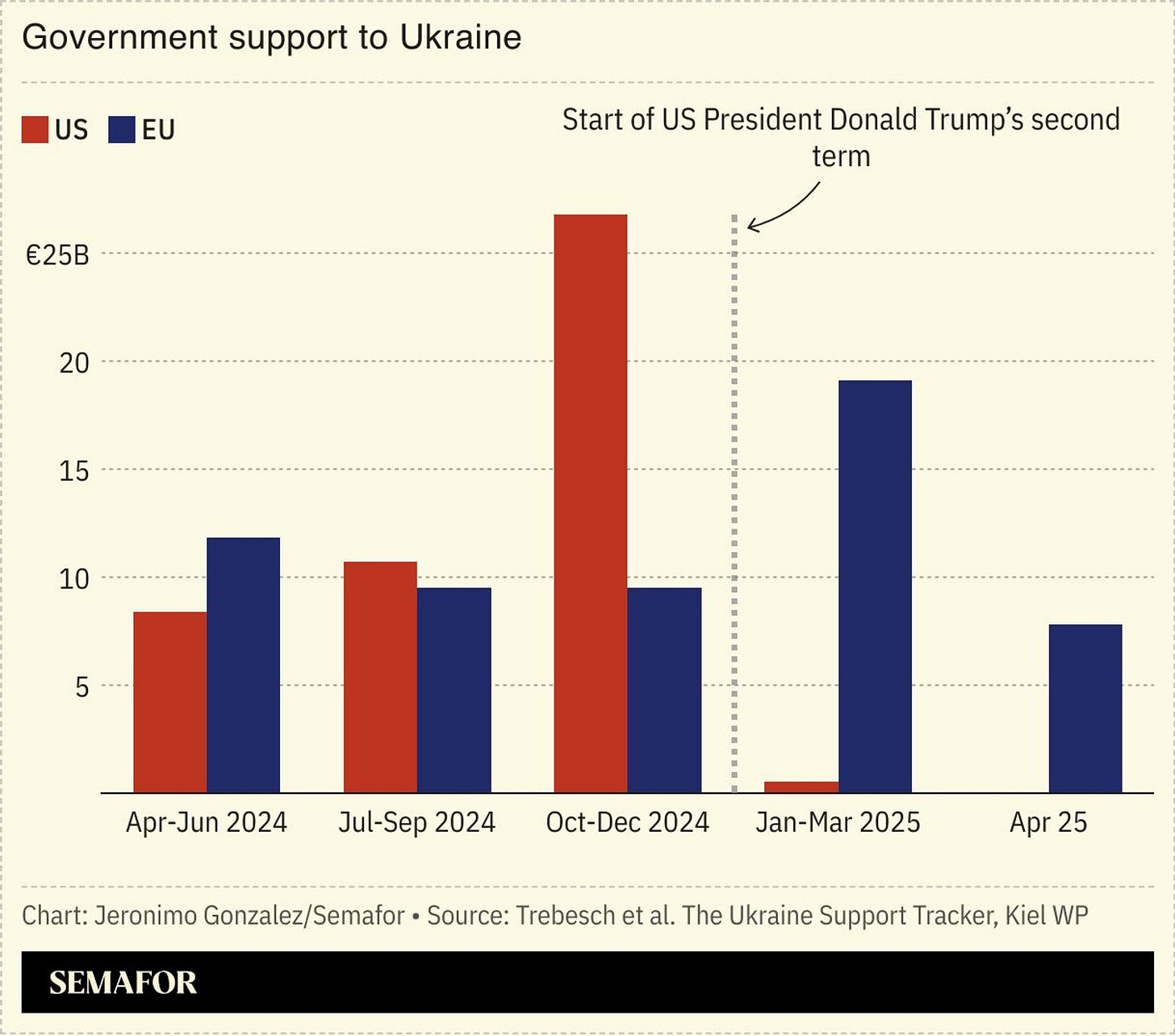$4 trillion club (crypto edition)💰 HODLers rejoice🤑 cyborg beetles and bees🪲🐝🎮 cosmic lighthouse📡👽🚨 moa money, moa problems🦅 plastivores🐛🛍️ blue marlin🚢☀️ #2025.28.2
How do we make killer robots... ethically?
Guten Tag from Berlin’s huge shiny new Brandenburg Airport where I’m currently in transit… a big step up from the aging Berlin Texel airport I used last time I was here for the Partnership on AI inaugural international gathering in 2017.

(Everything in the airport is *very expensive*! — I guess they have to pay for the massively overbudget public infrastructure project somehow…)
Here’s the delayed second half of this week’s newsletter… thank you for your patience while I got this to you…(Part 1 here ICYMI:)
An OS for Earth's survival🌍 $4 trillion club💰🏆 mechahitler🫣 perplexity comet☄️ hyperion⚡ Kimi-K2🤖 magical thinking on AI emissions🪄💨 a stormy week to Windsurf🏄♂️⛵ #2025.28.1
Welcome to this week's Memia scan across AI, emerging tech and the exponentially accelerating future. As always, thanks for being here!
🔮[Weak] signals
The usual crop of non-AI tech signals from the future… an even bigger than usual curation this week which is part of the reason I’m late publishing (my Sensorium feed-scanning tools are working rather *too* well after recent upgrades and surfacing nearly double the stories than usual…. so keeping everything brief with headlines and links with mostly AI-generated summaries. As always, please feel free to feed back on the signal-to-noise ratio as I progressively automate more of the newsletter production process…1 )
Consumer Tech
📱💻🔄 ChromeOS + Android: The merger that took a decade Google's Android chief Sameer Samat has officially confirmed the company will combine ChromeOS and Android into a single platform, ending months of speculation about a merger that's been predicted since 2013. The move aims to streamline development and better compete with Apple's iPad ecosystem, where Google's fragmented approach has consistently lagged behind. Only took them a decade to figure out what seemed obvious to everyone else.
📱🕵️♂️Spanish police profile Pixel users running GrapheneOS
Catalonian law enforcement has reportedly begun profiling Google Pixel users running GrapheneOS as potential criminals. (GrapheneOS is a privacy-focused Android alternative to Google’s surveillance-capitalist build, with superior security features like app sandboxing, granular app permissions, and a "duress PIN" that wipes data under coercion.)
Narrative: Since when was using open-source privacy tech a reason for police suspicion???
A huge week in Crypto
🤑HODLers rejoice…
🚀 Bitcoin breaks US$122,000 as Congress enters "crypto week"Bitcoin smashed through the US$122,000 barrier, hitting the an all-time high price of $122,979.87 on July 14 as US lawmakers prepare to vote on cryptocurrency legislation during what's being dubbed "crypto week" in Congress.
💰US$4 trillion club Just as I am writing this, the whole Crypto sector now exceeds US$4 trillion in market capitalisation value. Same as Nvidia.
Satoshi Nakamoto becomes world's 11th richest person Bitcoin's mysterious creator Satoshi Nakamoto has theoretically become the world's 11th richest person with BTC hitting US$120,000, making their estimated 1.096 million Bitcoin stash worth over US$131 billion. Bitcoin needs another 208% spike to $370,000 for Nakamoto to surpass Elon Musk.
Bhutan moves $74M in Bitcoin to Binance Bhutan's government has transferred 650 Bitcoin worth US$74 million to Binance over two weeks, timing their liquidation moves perfectly as BTC hit new all-time highs above US$120,000. The small Himalayan kingdom (population 770,000) now holds 11,411 BTC (worth nearly US$1.4 billion) through its investment arm Druk Holding, making it one of the most crypto-forward nations globally. "Gross National Happiness" = hodling Bitcoin?
Commentary and 2nd-order effects:
🏛️Bitcoin rally driven by US deficit concerns? analysts are increasingly vocal arguing the rally isn't crypto hype but a macro hedge against America's spiralling fiscal situation, with Trump's debt ceiling increase creating a potential US$7 trillion deficit swing.
💰GENIUS Act could trigger global financial crisis The US Senate's GENIUS Act aims to regulate stablecoins (cryptocurrencies pegged to traditional currencies) but economist Sergi Basco warns it could inadvertently set up the next global financial crisis. The legislation opens the door for major corporations like Amazon and Walmart to issue their own dollar-pegged tokens, essentially creating a fragmented ecosystem of corporate currencies that could destabilise global markets if any major issuer can't honour redemptions.
Narrative: What happens if every Fortune 500 company becomes its own central bank?
📈 Bitcoin flips Amazon to become world's 5th largest asset Bitcoin surpassed US$2.4 trillion market cap, overtaking Amazon, Silver, and Alphabet to become the world's fifth-largest asset by market capitalisation. The surge was fuelled by a seven-day buying streak from US spot Bitcoin ETFs, which pulled in over US$1 billion in net inflows last Friday alone.
For once, Bitcoin’s rise seems to have dragged up Ethereum (as well as a raft of other cryptocurrencies). ETH currently sitting around US$3600 after losing its lustre for most of 2025:
⚡🔐 Ethereum's Zero-Knowledge makeover ETH was also dragged up with the newly-revamped Ethereum Foundation outlining plans to integrate zero-knowledge proofs directly into the layer-1 blockchain within a year, replacing traditional block execution with cryptographic receipts that validators can check instead of re-running every transaction. The ambitious roadmap targets sub-10-second proof generation on hardware costing under US$100,000 and consuming less than 10 kilowatts—specs designed to keep validation accessible to home operators rather than centralised data centres.
US Federal agencies warn banks of crypto custody risks Three US federal agencies released guidance outlining key risks for banks considering crypto custody services, including liability for lost assets, compliance burdens, and the complexity of managing an evolving asset class. Notably, banks remain responsible for third-party custodians' actions—a detail that could prove costly if a Coinbase or another exchange gets hacked.
F**k around, find out High-leverage crypto trader James Wynn deactivated his X account after losing hundreds of millions of dollars through risky Bitcoin positions, with his wallet balance now sitting at a mere US$10,176. The trader, who openly admitted to "effectively gambling" changed his bio to simply "broke" before disappearing from social media entirely.
Also in Crypto this week:
🏦🇦🇺 Project Acacia: Australia's CBDC Reality Check
Australia's Reserve Bank is launching phase two of Project Acacia, testing CBDCs, stablecoins, and tokenisation across 24 real-world use cases with major banks including Commonwealth Bank, ANZ, and Westpac over the next six months. The trials will examine everything from repo markets to carbon credits, with 19 involving actual money and five running as proof-of-concept simulations, results due Q1 2026.
🏧Aotearoa bans crypto ATMs to combat money laundering The New Zealand government announced a total ban on cryptocurrency ATMs as part of a major AML regime overhaul. The move affects over 220 crypto kiosks nationwide and grants expanded surveillance powers to the Financial Intelligence Unit.
Tech regulation
🛡️Five EU states test age-verification app for children Following Australia’s yet-to-be-proven age-verification initiative, the European Commission is leading an initiative in five EU countries (Denmark, France, Greece, Italy and Spain) are testing a prototype age-verification app, ostensibly to prevent children from accessing harmful online content, with each nation customising their own version to match local regulations—France wants 15+ for social media, others may vary.The European Commission's latest salvo in its ongoing battle with Big Tech also includes recommendations to remove "addictive" features like read receipts and default notification settings that disrupt sleep patterns.
There are so many privacy challenges here: this may drive sudden demand for Zero-Knowledge proof technology to assert the user’s age without disclosing their identity. If democratic governments restrict anonymous access to the internet then that has potentially terrifying downsides if an authoritarian regime takes control…
🆔Bluesky adds UK age verification for Online Safety Act
Bluesky is rolling out age verification in the UK ahead of the July 25th Online Safety Act deadline, offering face scanning, ID uploads, or payment card verification through Epic Games' Kid Web Services. Users who don't verify will face restricted features including blocked adult content and disabled direct messaging, while platforms risk fines up to £18 million or 10% of global revenue for non-compliance.
Narrative: Is this a step towards balkanisation of the globalised internet, where platforms must implement country-specific features that fundamentally alter user experience based on geography rather than user choice? (And what about VPNs?)
⚖️EU releases voluntary AI code to ease compliance The EU released a voluntary code of practice to help businesses comply with its landmark AI Act, focusing on transparency, copyright protections, and safety for general-purpose AI systems like ChatGPT. While enforcement begins 2 August, the EU won't actually start penalising violations for at least another year, with potential fines reaching €35 million or 7% of global revenue. Over 40 European companies including Airbus and Mercedes-Benz are pushing for a two-year delay, arguing the regulations are too complex and could hamper Europe's AI competitiveness—but so far Brussels shows no signs of backing down.
🇫🇷 French prosecutors probe X's algorithmic "foreign interference" French magistrates have launched an investigation into X over allegations that Musk's platform manipulated its algorithms to enable foreign interference and illegally harvested user data. The probe stems from a January complaint claiming X spread "massive amounts" of hateful content designed to distort France's democratic debate.
🛒🇮🇩 TikTok's Indonesian E-commerce experiment goes sideways
TikTok's US$840 million acquisition of Indonesian e-commerce giant Tokopedia has turned into a cautionary tale of forced integration, with sellers reporting 50%+ revenue drops and a mass exodus to competitors after being pushed into video-first marketing. The merger, designed to comply with local laws banning social media companies from running e-commerce, has instead alienated the very merchants it was meant to serve, with many saying Tokopedia has "lost its soul" and become "just another generic Chinese marketplace."
With ByteDance facing similar regulatory pressure to restructure TikTok in the US, Indonesia's messy experiment suggests that compliance-driven corporate surgery often kills the patient rather than curing the disease.
Biotech
🧬Gene therapy slashes “bad” cholesterol by 53% Verve Therapeutics' VERVE-102 gene therapy delivered a 53% average reduction in "bad" LDL cholesterol with a single IV dose in early trials, using safer CRISPR base editing to target the PCSK9 gene. The treatment showed up to 69% LDL reduction in the highest dose group, with Lilly acquiring the company and the FDA granting Fast Track status for this potential "one-and-done" cardiovascular therapy.
🧠⏰Brain scan predicts Alzheimer's risk decades early
Researchers have developed a single MRI brain scan that can predict your biological aging speed at age 45 and forecast dementia risk, chronic disease likelihood, and mortality decades into the future. The DunedinPACNI tool, trained on New Zealanders tracked since birth, found fast agers were 60% more likely to develop dementia and 40% more likely to die within years.
🦅 Moa money, moa problems
Colossal Biosciences announced plans to "de-extinct" New Zealand's giant moa in partnership with Canterbury Museum and filmmaker Peter Jackson, following their dubious "dire wolf" success (which was actually just a genetically modified grey wolf). However, University of Otago researcher Nic Rawlence systematically dismantles the feasibility, pointing to the 60-million-year evolutionary gap between moa and their closest living relative, the South American tinamou, plus the lack of suitable surrogate eggs and indigenous Māori opposition to the project.
(I discussed this scenario in my book Fast Forward Aotearoa last year — it’s an interesting philosophical thought experiment: where should nature conservation begin and end?)🐛🛍️Plastivores
Canadian researchers have discovered that 2,000 waxworms can devour an entire polyethylene bag in 24 hours, converting the plastic into body fat through their digestive processes. While promising for tackling the 100 million tonnes of polyethylene produced annually, scaling this solution would require billions of continuously munching caterpillars.
Robotics
So much happening in the world of robots… in approximate order of reality through to science-fiction…
Perseverance rover sets Mars driving record with 411-meter journey
NASA's Perseverance rover just smashed the single-drive distance record on another planet, covering 411 metres in one go thanks to its self-driving software that processes images while rolling. Unlike its predecessors Curiosity and Opportunity, which must stop-look-think before each move, Percy can literally think on its wheels – a game-changer for planetary exploration efficiency.
Robot vacuum with arm finally picks up shoes
Roborock's US$2,599 Saros Z70 claims to be the first commercial robot vacuum with an actual robotic arm designed to pick up objects before cleaning—(except according to that review it mostly just picks things up and puts them back down again.)
⚔️Ukraine's robots capture Russian soldiers in world-first unmanned assault
Ukraine's 3rd Separate Assault Brigade claims to have conducted the world's first fully unmanned offensive operation, using kamikaze drones and ground robots to capture Russian soldiers in Kharkiv region. The experimental "DEUS EX MACHINA" drone company destroyed a Russian bunker with a kamikaze ground robot, prompting remaining soldiers to surrender to approaching unmanned systems before being escorted back by overhead drones.
Kinisi's KR1 humanoid robot automates warehouse picking tasks
US startup Kinisi Robotics has launched KR1, a wheeled humanoid robot that can handle 10kg payloads for up to 8 hours while learning warehouse tasks through simple human demonstrations. The bot operates entirely offline with onboard AI and features a "data flywheel" where each robot's learnings get shared across the entire fleet, creating a collectively smarter workforce.
CARA: rope-driven robot dog with 12 motors
Purdue engineering student Aaed Musa has built CARA, a quadrupedal robot that ditches traditional gears for a rope-based capstan drive system using high-strength Dyneema cord and 12 brushless motors. The bot features custom 3D-printed parts, carbon fibre construction, and sophisticated inverse kinematics coding that gives it an eerily lifelike gait.
🤖🏥⚕️ Humanoid surgical robots
UC San Diego researchers successfully demonstrated a teleoperated Unitree G1 humanoid robot performing seven different medical procedures, from physical examinations to emergency interventions and precision needle work. The bimanual system achieved a 70% success rate on ultrasound-guided injections and completed tracheostomy procedures in under 20 seconds, though it struggled with force-intensive tasks and fine motor control like suturing.
✂️ Robot surgeon achieves 100% success in gallbladder removal tests
Johns Hopkins researchers have developed SRT-H, an autonomous surgical robot that achieved a 100% success rate performing gallbladder removals on realistic human-like models, using ChatGPT-like language model to respond to voice commands and adapt in real-time. The robot learned from surgical videos and can adjust its approach mid-procedure.
🐕Robot learns animal-inspired movement in nine hours
Researchers at University of Leeds and UCL have created "Clarence," a four-legged robot that autonomously adapts its gait to navigate unfamiliar terrain, mimicking how dogs, cats, and horses naturally adjust their movement. The AI system learned these bio-inspired locomotion strategies in just nine hours of simulation training—significantly faster than the days or weeks it takes actual animals to master terrain navigation.
🪲🎮Cyborg beetles and bees
ZoBorgs Australian and Singaporean researchers have created "ZoBorgs" - cyborg beetles equipped with microchip backpacks that can be remotely controlled via game controller to navigate rubble and climb walls with 92% obstacle success rates. The darkling beetles receive electrical signals through their antennae and wing covers, allowing precise directional control while maintaining their natural three-month lifespan.
🐝🧠 World's lightest brain chip to control bees
Chinese researchers have developed the world's lightest insect brain controller at just 74 milligrams, enabling 90% reliable control of bees through direct neural interface via three brain-piercing needles. The Beijing Institute of Technology team envisions fleets of mind-controlled insects for military reconnaissance and disaster relief operations, though power limitations and insect fatigue remain significant hurdles.
China warns military humanoid robots risk indiscriminate killings
China's official military newspaper has called for urgent ethical and legal research on humanoid military robots, warning they could lead to "indiscriminate killings and accidental deaths" while *clearly* violating Asimov's First Law of Robotics. The People's Liberation Army Daily argues these human-like weapons need strict legal frameworks governing battlefield behaviour, autonomous violence detection, and force limitation capabilities.
Narrative: A military publication essentially asking "how do we make killer robots... ethically?"
Aircraft and drones
Speaking of military technology….
SPRINT X-plane: 517 mph tiltrotor
DARPA has greenlit Bell Textron to build and test a revolutionary X-plane that can cruise at 517 mph while maintaining helicopter-like hovering capabilities, featuring first-ever "stop/fold" rotor technology. This represents a significant leap beyond the current V-22 Osprey's 351 mph top speed, potentially transforming military aviation capabilities.
🛩️China “accidentally” reveals J-35 stealth fighter production
Chinese state media CCTV managed to "accidentally" showcase two J-35 stealth fighters lurking in the background during a segment about the J-15T carrier fighter at Shenyang Aircraft Corporation's facilities. Military analysts universally interpreted this as deliberate exposure of China's fifth-generation naval fighter programme, which appears further advanced than previously known, with the aircraft sporting protective coatings and carrier-specific tail hooks.
🌊✈️ Seaglider successfully demonstrates hydrofoil flight capabilities
Back on civvy street, Regent's 16.8-metre electric seaglider successfully completed its first hydrofoil tests, rising from the water before gliding along the surface. The three-mode vessel (float, foil, fly) uses wing-in-ground-effect technology to achieve 290km range while staying within 20 metres of the water surface, with the hydrofoil capability addressing the stability issues that doomed Soviet-era ekranoplans. With a claimed US$10 billion in orders and US Coast Guard certification progressing, this feels like watching the birth of a genuinely new transportation category.
🚁Rescue drone beats helicopter to mountain summit
Jetson's personal eVTOL aircraft climbed 1,211m to a Polish mountain summit in under four minutes during rescue trials, outpacing helicopters while handling 58 km/h winds that would ground traditional aircraft. The 115kg electric aircraft demonstrated it could cover 700 km² of remote terrain from a single mountain base, with Poland's GOPR rescue team identifying genuine operational potential as a "rescue spearhead" for first response.
🚁💥🇭🇹Haiti deploys kamikaze drones against violent gangs
Haiti's transitional government is deploying explosive "kamikaze" drones against gangs that control over 85% of Port-au-Prince, with officials claiming over 300 gang members killed. They claim that the drone strikes represent a "game-changer" in urban warfare tactics, though critics question whether the conflict legally constitutes a war and worry about setting precedents for lethal autonomous weapons in civilian areas.
Narrative: Will more failed states embrace Silicon Valley's most dystopian military tech to survive? If so what are the boundaries in international law?
Computing
💥🔴💾 Mission: Impossible SSD
TeamGroup's new P250Q-M80 SSD can literally self-destruct on command, using either software wipes or a hardware kill switch that sends high-voltage surges through the NAND chips until they're physically destroyed. Aimed at defence, AI development, and crypto sectors, the drive combines PCIe Gen4 performance (up to 7,000 MB/s reads) with military-grade durability and that satisfying red button we've all been waiting for since watching spy films.
🥞💧 Pancaked droplets
Europe's fastest exascale supercomputer JUPITER (the world's 4th fastest) got its stress test from Georgia Tech researchers simulating shock waves hitting water droplets, which deform into pancake shapes before breaking apart. The simulations, part of the ExaMFlow project, help design safer supersonic aircraft and less invasive medical shock wave treatments while proving the 24,000 NVIDIA Grace Hopper chip system can handle extreme computational loads.
Rubin Observatory's massive "data butler"
The new Vera C. Rubin Observatory will generate 20 terabytes of data nightly and 10 million alerts, requiring a distributed cloud computing network across three continents and seven AI "brokers" to filter signals from noise. A system called the "Data Butler" manages metadata queries, because manually searching through 1.5 million images that are each 10,000 pixels wide would be like finding a specific photo on your phone if it contained every image ever taken. Even this massive undertaking will be dwarfed by the upcoming Square Kilometre Array, which will generate an order of magnitude more data.
Transport tech
🚗 Stellantis joins the hydrogen mobility graveyard
Carmaker Stellantis has formally retreated from hydrogen fuel cell vehicles just months after launching eight van models in early 2024, citing prohibitively high costs that left their vehicles 80% more expensive than battery-electric alternatives. The automaker's pivot follows a global pattern of hydrogen mobility failures, from Renault's liquidated Hyvia joint venture to Nikola's bankruptcy and fraud conviction, while infrastructure promises across Europe remain largely undelivered.
⚡🏆Lucid Air smashes EV range record with 1205km drive
Lucid Motors' Air Grand Touring just obliterated the single-charge EV distance record, covering 1,205 km from St. Moritz to Munich without stopping—beating Mercedes' previous 1,045 km record. Serial record-breaker Umit Sabanci piloted the 819-horsepower luxury sedan through a strategically planned route that maximised regenerative braking from a 1,310m elevation drop. At US$112,650, it's hardly mass-market accessible, but the tech demonstration suggests range anxiety's days might be numbered.
🏍️Trinova's tilting three-wheeler
California engineer Markus Scholten has built a fully-enclosed, tilting three-wheeler that promises motorcycle agility with car-like protection. The Trinova's 850mm width enables lane-splitting where legal, while dual hub motors deliver 0-97 km/h in 3.5 seconds and up to 225km range for a projected US$18,000-22,000. Will regulators and insurance companies treat this 340kg curiosity as the motorcycle it technically is, or demand car-like safety standards?
🚶♂️🔍MIT's HEXWAVE system revolutionises airport security screening
MIT Lincoln Laboratory's HEXWAVE system lets passengers walk through security screening without stopping, posing, or removing items, using microwave imaging that's 100x faster than current body scanners. In the US the TSA is now testing it to replace metal detectors for PreCheck passengers, while airports nationwide are already deploying it for employee screening ahead of a 2026 mandate.
Energy
☀️🇪🇺 Solar supremacy: EU's renewable milestone
A new report from energy analysts Ember confirms that solar power became the EU's largest electricity source for the first time ever in June 2025, generating 22.1% of total electricity and narrowly edging out nuclear at 21.8%. At least 13 EU countries smashed monthly solar generation records while coal plummeted to a historic low of just 6.1% of the energy mix. However, the broader energy story reveals some complexity with fossil fuel generation actually up 13% in the first half of 2025 due to drought-affected hydropower.
The real game-changer will be whether battery storage can finally solve the morning-and-evening fossil fuel problem that still infects grid pricing.✈️🔋Airports become energy nodes to boost grid resilience?
NREL and NASA are exploring how regional airports can transform into "energy nodes" as electricity demand could quintuple over the next 20 years due to electric aircraft and ground equipment. Their ÆNodes research project is testing how on-site power generation and storage at airports can offset infrastructure costs while providing grid stability and revenue streams.
🚢☀️ Blue Marlin: World's first hybrid solar cargo ship launches
Dutch innovator Wattlab and German shipping giant HGK have launched the Blue Marlin, the world's first hybrid solar cargo vessel that directly feeds solar power into its propulsion system via 192 panels generating 37,500 kWh annually. The 86-metre inland waterway vessel can haul 3,110 tonnes of cargo while cutting CO2 emissions by 36,000 kg per year
Climate Tech
🦠🏗️ Fossil-inspired bioconcretecaptures 142% more CO2
University of Pennsylvania researchers have 3D-printed concrete infused with diatomaceous earth (fossilized algae remains) that captures 142% more CO2 than traditional concrete while using 68% less material. The breakthrough material draws inspiration from diatoms—microscopic algae whose intricate silica shells provided the geometric blueprint for lattice structures that actually get stronger as they absorb carbon dioxide. Concrete currently accounts for ~8% of global emissions
🛰️💨US$88M MethaneSat goes silent
Jeff Bezos's $100M-backed MethaneSat has gone dark since 20 June, taking with it humanity's best shot at catching the oil and gas industry red-handed with their methane leaks from orbit. The Environmental Defense Fund's satellite, which could survey in 20 seconds what aircraft needed 2 hours to cover, is now "likely not recoverable". Previous ground-based measurements revealed US methane emissions were actually 60% higher than EPA estimates.
Narrative: Conspiracy theory in the making…?
3D printing
🫀🖨️3D-printed aorta model saves life in complex surgery
Brisbane surgeons used a multi-material 3D-printed model to rehearse replacing a man's catastrophically enlarged aorta—swollen to four times normal size at 8cm diameter—in a nine-hour procedure that required stopping his circulation for 20 minutes. The Herston Biofabrication Institute's "digital anatomy" printer created a tactile rehearsal tool combining rigid and soft materials, allowing surgeons to practice on a life-sized replica before the actual operation.
🖨️🏫Qatar builds world's largest 3D-printed school complex
At the other end of the 3D-printing scale, Qatar is constructing what it claims are the world's largest 3D-printed buildings—two schools totaling 40,000 square metres , allegedly 40 times larger than any previous 3D-printed structure. The project uses custom COBOD printers measuring 50m x 30m x 15m to extrude cement-like mixture in layers, creating desert dune-inspired curved walls before human workers add roofs, windows, and finishing touches.
Materials science
Scientists use DNA “origami” to build 3D nanomaterials
Columbia's Oleg Gang has cracked the code for building complex 3D nanomaterials using DNA as programmable scaffolding, with strands folding into octahedral "voxels" that self-assemble like molecular jigsaw puzzles. His MOSES algorithm enables inverse design of arbitrary 3D structures for applications ranging from optical computers to brain-mimicking circuits, all assembled in parallel in simple water baths. The approach sidesteps traditional lithography limitations while offering environmentally friendly, massively parallel fabrication at the nanoscale.
🦠🔄Bacteria-grown cellulose plastic alternative in a single step
University of Houston researchers have cracked the code on growing biodegradable plastic alternatives using guided bacteria in a spinning incubator, producing cellulose sheets with 553 MPa tensile strength that could replace conventional plastics. The single-step process controls bacterial movement to create aligned nanofibres, enhanced with boron nitride for superior thermal properties.
Narrative: Watching developments like these for a potential inflection point where the economics of biological nanomanufacturing finally scales to challenge petroleum-based materials outside the lab.
👅Graphene artificial tongue achieves 98.5% taste accuracy
Researchers have developed a graphene oxide-based artificial tongue that achieves 98.5% accuracy identifying known tastes and 75-90% accuracy on novel flavours, using machine learning trained on 160 different chemicals in a nanofluidic device that works in moist environments. The system successfully identified complex tastes like coffee and cola, integrating both sensing and computing functions into a single device—a first for artificial gustatory systems.
Space tech
⚡🛰️ UK-ODESSI: SentinelUK launches Europe's first solar storm monitoring satellite

Artist’s impression of what the UK-ODESSI space monitor could look like. Image: SSTL and STFC RAL Space The UK is developing Europe's first homegrown solar storm monitoring satellite, UK-ODESSI, featuring a coronagraph to track coronal mass ejections and a high-energy particle detector—both filling critical gaps in European space weather capabilities. The low-cost pathfinder mission aims to launch within five years, potentially ending Europe's reliance on US assets for the 15+ hour CME arrival forecasts that keep Earth’s increasingly fragile digital infrastructure from getting fried by solar outbursts.
🛰️🗑️UK seeks £75.6M space robot to remove orbital debris Staying with Britain, The UK Space Agency is tendering for a robotic spacecraft to capture and de-orbit two defunct British satellites by 2028, with a £75.6 million (US$103 million) budget that seems almost symbolic given the scale of orbital debris. ( Apparently the Brits estimate there are in excess of 54,000 tracked objects larger than 10cm currently orbiting Earth, and 140 million+ pieces of space junk smaller than 1cm.
Narrative: The beginnings of a multi-$billion “in-orbit services” space market tasked with cleaning up the escalating space debris problem … before it causes permanent damage to critical infrastructure such as GPS, Earth observation and internet satellites.
🛰️✂️Space industry warns against Tracss collision alert system cuts
The US government wants to slash funding for its space traffic coordination system by 85% just as thousands of new satellites crowd low Earth orbit, prompting 450+ space companies including SpaceX to sound the alarm. With Starlink manoeuvres up 200% in six months and Chinese mega-constellations planning 26,000 satellites, the US Congress thinks private industry can handle space traffic control instead.
Narrative: Which country will drive international body setting traffic standards if not the US? (Answer… you know the answer…🇨🇳)
📡👽🚨 Cosmic Lighthouse: we've been screaming at aliens since the 1950s
New research from the University of Manchester reveals that Earth's civilian and military radar systems have been broadcasting a distinctly artificial signature detectable by alien civilisations within 200 light years for the past 75 years. The combined 2×10¹⁶ watts from airport radar plus focused military signals essentially turned our planet into a "cosmic lighthouse" during the Cold War, making the long-running SETI debate about whether to send messages somewhat academic. The study suggests any civilisation with Green Bank Telescope-equivalent tech could easily spot us, while Arecibo-class observers could detect us from 60,000 light years away.
Narrative: Oops
⏳ Zeitgeist
Also a bunch of non-tech developments catching in my net as well this week… unfortunately it’s a turbulent world out there. Brief headlines and summaries:
Climate change
⏰Heat waves lengthening faster than global warming
UCLA and Chilean researchers have discovered that heat wave duration is accelerating faster than global warming itself, with each fraction of a degree creating exponentially longer extreme heat events. The longest heat waves—those lasting weeks—will see the greatest increases in frequency, with equatorial Africa potentially experiencing 35+ day heat waves 60 times more often by 2044 compared to recent decades.
🌡️Western Europe records hottest June with 2,300 heatwave deaths
Case i point: Western Europe just endured its hottest June on record, with temperatures hitting 46°C and Mediterranean sea surface temps reaching a scorching 27°C—all tracked in real-time by the EU's Copernicus satellite network. New climate attribution research suggests human-induced warming added 2-4°C to the heat, potentially causing 1,500 excess deaths out of an estimated 2,300 total fatalities during the late June heat dome.
🔥Grand Canyon's North Rim evacuated due to wildfire Wildfires forced the evacuation of the Grand Canyon's North Rim as the White Sage Fire burned through 400 hectares near Jacob Lake, Arizona.
🌊Climate change made Texas floods 20-30% more severe
Climate attribution science has determined that the devastating Texas floods of July 2025—which killed 120+ people and caused billions in damage—were made 20-30% more severe by climate change, despite rainfall being only 7% heavier due to warming.
🌋❄️🔄Melting glaciers could awaken hundreds of volcanoes worldwide
New research suggests that melting glaciers could reawaken hundreds of dormant volcanoes worldwide as reduced ice pressure allows underground magma to expand and erupt more explosively. The phenomenon operates on geological timescales—taking 3,000-5,000 years from ice retreat to major eruptions—but creates a concerning positive feedback loop where volcanic emissions accelerate further warming and melting. There are over 100 hidden volcanoes beneath Antarctica's ice and similar risks across North America, New Zealand, and Russia.
Renewable energy
⚡Offshore wind secures billions in new financing deals
The offshore wind industry is clawing back from its 2023 near-death experience, with over 11 GW of projects securing financing in the first half of 2025 — more than all of 2024 — led by Ørsted's US$3 billion Taiwan expansion and a US$5.2 billion Iberdrola-Masdar UK deal. The momentum appears to be expanding existing wind farms rather than building from scratch, combined with government-backed contracts that shield developers from the inflation whiplash that previously made projects unprofitable between signing and switch-on. However, the US offshore wind sector faces an existential crisis as Trump's tax credit cuts leave projects with no viable path to competitiveness.
⚡🔋🏔️ China's 490 million-tonne lithium motherlode China has discovered a massive hard-rock lithium deposit in Hunan Province containing 490 million tonnes of ore with 1.31 million tonnes of lithium oxide, further cementing its battery supply chain dominance. The altered granite-type deposit offers faster processing than brine extraction and includes bonus minerals like rubidium and tungsten, making it economically attractive for rapid development.
The discovery could accelerate China's lithium self-sufficiency as domestic EV demand doubles by 2030.
Planet in conflict
Israeli strike kills children waiting for water in Gaza An Israeli missile strike killed ten civilians, including six children, at a Gaza refugee camp on Sunday, with Israel's military attributing the tragedy to a "technical error" that caused the weapon to hit far from its intended target
I can’t even…😥
Yemen’s Houthis sink two Red Sea ships Yemen’s Houthi militants sank a second cargo ship in the Red Sea in one week.
Key optics:
Houthi attacks threaten 15% of global maritime trade through Red Sea shipping routes.
Previous peak attacks caused a two-thirds drop in cargo traffic and soaring insurance costs.
Escalating attacks after ceasefire period could severely disrupt international supply chains again.
💥Ukraine intercepts 319/597 drones in massive Russian assault
Russia launched its largest coordinated drone assault yet against Ukraine, deploying 597 attack drones and 26 missiles, killing six and wounding dozens. Ukraine's air defence claimed it intercepted 319 drones and 25 missiles—a 51% success rate against an overwhelming swarm that included Iranian Shahed "kamikaze" drones and decoy "simulators" designed to overload defensive systems.
Narrative: The scale of this attack demonstrates that autonomous drone warfare systems are rapidly transitioning from force multipliers to primary weapons platforms for strategic bombardment. Corollary: Military doctrine is changing faster than traditional defence procurement cycles can adapt.
Meanwhile Trump threatens Russia tariffs and unveils a plan to arm Ukraine with patriot missiles. Who knows WTF is going on here… but war is expensive people!
⚔️💻Trump administration allocates $1B for offensive cyber operations The Trump administration is allocating US$1 billion over four years for "offensive cyber operations" targeting the Indo-Pacific region (read: China) while simultaneously slashing US$1 billion from cyber defence budgets.
One US senator warned that expanding US government hacking capabilities (while de-funding cyber defence…) will "invite retaliation" against civilian infrastructure like hospitals and local governments that can't defend against nation-state actors. Well, quite.
⚛️🚨Health issues plagued nuclear-armed leaders
Finally, a University of Otago study (co-authored by regular Memia correspondent Matt Boyd) of 51 deceased leaders from nuclear-armed nations reveals a disturbing pattern: many were significantly health-impaired while wielding nuclear authority, from Nixon's crisis drinking to JFK's hidden Addison's disease and amphetamine use. The research found 15 leaders had health issues severe enough to hasten their departure, with some cases involving profound impairment like comatose strokes or debilitating depression.
Narrative: As geopolitical tensions escalate and nuclear arsenals modernise, this study exposes the uncomfortable reality that our species' survival has repeatedly depended on the neurochemical stability of a handful of aging (male) politicians operating under extreme stress.
It feels like this needs better regulation, right?
Geopolitics
🎭📞 Deep State Deep Fakes
Someone impersonating US Secretary of State Marco Rubio used AI-generated voice and text messages via Signal to contact five senior officials, including three foreign ministers, in an apparent intelligence-gathering operation. The fraudster deployed a convincing fake email identifier and left voicemails attempting to extract sensitive information. A State Department investigation is underway…
Narrative: a preview of how nation-state actors (and others…) can exploit deepfake AI, potentially manipulating international relations in real-time. Many more incidents coming like this, incredibly hard to defend against, particularly with certain key actors playing fast and loose with Signal on their personal phones...
🐉 Is Xi's grip slipping? More Beijingology: as I flagged in Memia 2025.22 a couple of months ago, it seems there may be some substance to bubbling rumours that Xi Jinping's totalitarian grip on power is slipping: his two-week disappearance and conspicuous absence from the BRICS summit coincides with intensified purges of his own appointees and declining references to "Xi Jinping Thought" in state media. Also, the resurgent Hu Jintao faction appears to be positioning pragmatic successors like Wang Yang, who favour market reforms and less confrontational US relations, as Xi's economic promises remain unfulfilled.
🌍💰⚔️ Geoeconomics Finally, Financial Times columnist Gillian Tett traces how we've shifted from viewing economics as a quasi-scientific discipline separate from politics to a new school of "geoeconomics" - where trade, finance, and technology become weapons of statecraft. Commerce is being subordinated to national security imperatives not seen since the 1930s.
Narrative: how do smaller non-superpower nation states play to “win” on an emerging geoeconomics game board?
Liebe Grüße
Ben
Images illustrating stories are generally the ones accompanying the link in the social media sharing summary. Need to automate image credit captions with AI next…
As I mentioned, feedback welcomed - I personally find widening my sources to prepare and share these scans really helpful to keep my world model of current events / trends well informed and up-to-date… but is the quantity getting too much … or the AI-generated quality too little … as more and more of the process is automated? (Can you tell!?) And: are the meta-narratives helpful or annoying?







